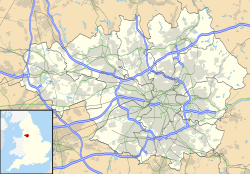Church of St Wilfrid, Northenden facts for kids
Quick facts for kids Church of St Wilfred, Northenden |
|
|---|---|

Church of St Wilfrid
|
|
| 53°24′26″N 2°15′13″W / 53.4071°N 2.2535°W | |
| Location | Northenden, Greater Manchester |
| Country | England |
| Denomination | Church of England |
| Churchmanship | Central |
| History | |
| Status | Parish church |
| Dedication | St Wilfred |
| Architecture | |
| Functional status | Active |
| Heritage designation | Grade II* |
| Architectural type | Parish church |
The Church of St Wilfrid is an Anglican church located in Northenden, a suburb of Manchester, England. You can find it on Ford Lane, very close to the River Mersey. It's about 8 kilometers (5 miles) south of Manchester city centre.
This church is quite old, originally built in the late medieval period. It was largely rebuilt in the 1800s by an architect named J. S. Crowther. He was known for his Gothic Revival style, which brought back medieval designs. The Church of St Wilfrid was recognized as a special historical building (a Grade II* listed building) on February 25, 1952.
Contents
History of St Wilfrid's Church
The Church of St Wilfrid might have started as far back as the Saxon times. It was even mentioned in the Domesday Book, a famous survey from 1086. The book talked about a "church (at) Norwardine" owned by Ranulf and Bigot.
The church building you see today mostly dates from the 1400s. However, it was changed a lot in the 1870s. In 1872, architect J. S. Crowther was hired to fix the church. He discovered that the old medieval church didn't have strong foundations. Because of this, he decided to completely rebuild most of it.
Architecture and Design
The Church of St Wilfrid is shaped like a cross when you look at it from above. It's built from red Alderley Edge sandstone and has slate roofs. The oldest parts of the church are from the 15th century.
Crowther's Rebuilding Work
From 1873 to 1876, J. S. Crowther rebuilt much of the church. He added many Gothic decorations. These include carved grotesques (funny or scary stone carvings) and crocketed pinnacles (pointy towers with leaf-like decorations). Crowther also added two round stair turrets. He had planned to rebuild the bell tower too, but this never happened. So, the tower is the only part of the church that is still mostly medieval. It's built in the Perpendicular Gothic style, which means it has tall, thin windows and strong vertical lines.
Inside the Church
Inside, you can find some original medieval rood screens. These are carved wooden screens that used to separate parts of the church. One screen above a doorway in the south chapel is very interesting. It shows "a pair of tumblers and a monkey sitting on a drum." The tumblers are carved in a way that they really look like they are tumbling!
Next to the main part of the church (the nave) is the Wythenshawe Chapel. This chapel holds the burials of the Tatton family, who lived nearby at Wythenshawe Hall. There are many old and beautiful monuments here. These include memorials to members of the Tatton and Egerton families. For example, there's a monument to Robert Tatton (who passed away in 1689) with small angel figures called putti. Another shows a woman lying on a sarcophagus for William Egerton (who passed away in 1806).
Stained Glass Windows
The church has a full set of beautiful Victorian stained glass windows. These windows were made in the 1850s. They were saved from the old church and put back in after Crowther's rebuilding. It's thought that the Tatton family or the Watkin family (from Rose Hill, Northenden) donated these windows.
The windows were created by famous stained glass artists. These include Charles Eamer Kempe, William Wailes, and Henry Hughes. The church also has windows designed by Percy Bacon Brothers and Humphries, Jackson and Ambler.
Graveyard and Notable Burials
The church has a large graveyard. Here, you can find the tomb of Sir Edward Watkin, who was a very important railway businessman in the Victorian era. Many members of the Tatton family are also buried here.
The churchyard also contains war graves. These are the graves of eleven service personnel who died in the World War I and World War II.
See also
- Grade II* listed buildings in Greater Manchester
- Listed buildings in Manchester-M22



